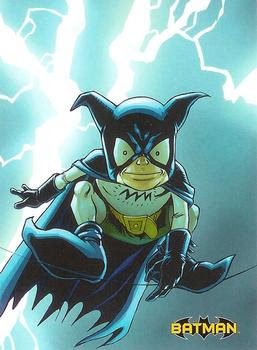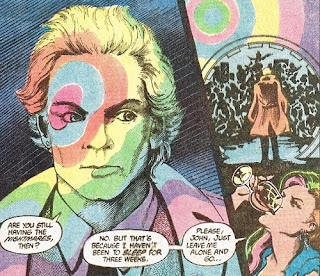Earlier this year I went on a "Batman binge" and feverishly visited every non-sports trading card vendor I could in order to pick up whatever Batman-related trading cards I could find. I purchased quite a few sets. It was only in the last few weeks that I actually sat down to take a look at what I'd purchased (I'm funny like that) and realized that the 2013 Batman: The Legend trading cards were, in fact, published by Cryptozoic. I reviewed a Cryptozoic trading card set back in August, and being somewhat impressed with it, decided to really sit down and scrutinize the Batman: The Legend trading cards I had purchased earlier this year. So now that you have some context, I'm just going to take the plunge...
Cryptographic's Batman: The Legend trading card set advertises 63 cards of all-new original art in the base set and three chase card sub-sets (9 Batmobile foil chase cards, 9 Batcave puzzle cards and 8 Circus of Villains poster chase cards), bringing the entire set to 89 cards. (This doesn't count the 49 different Oversized Art redemption cards, the parallel holofoil base card variants, nor the gazillion artist sketch card chases that are also included in this set. Also, there's an exclusive Printing Plate card and I'm not even sure what that means.)
I wouldn't say that Batman is my favorite DC character, but he is my favorite among DC's "Big Three" [Superman, Wonder Woman & Batman] and probably one of the company's most marketable characters (and thus attainable to collect). There is never a shortage of Batman products/publications on the market in this day and age targeted to all different demographics of collectors/fans. A lot has happened to Batman since I last stopped *really* reading the comic in the mid 1990s; new villains, new allies, new 52. I'd still check in from time-to-time to see what was going on, but it was more of a passive interest rather than a "oh boy, I can't wait to see what happens next issue".
Batman has an incredibly rich legacy spanning as far back as the 1940s, so I'd imagine it would be challenging for Cryptozoic to decide on what to focus on in an 89 card set. This set was released (I'm assuming) to coincide with the release of Christopher Nolan's 2012 The Dark Knight Rises film, when excitement about the film was at a fever pitch. A 63 base card set is pretty tight, so I'm kind of curious on what they decided "made the cut" for being set-worthy.
We've had a few notably good non-movie Batman trading card sets in the past two and a half decades [I'm looking at you Batman: Saga of the Dark Knight and Batman Master Series], so the bar will be set pretty high on this one. These aforementioned sets are also both twenty years (or more) old, so it was time for an update.
[I'm not going to through these card-by-card, just a general overview with some highlights.]
The first eleven cards are Batman Ally characters (including Batman himself), and then we dive right into the iconic Bat Villains. I'm partially scanning these for eighties references, and the first one that comes up is card #5 - Jason Todd.
According to the text on the back of the card, Jason Todd's 1988 death at the hands of the Joker is still being honored. Red Hood and the Outlaws is a book that debuted in 2011's New 52 relaunch, so it looks like Jason Todd's history remained intact. The same goes for Oracle (Barbara Gordon), since the text on the back of her card references her being shot by the Joker. Upon a second glance, Barbara Gordon actually has three cards in this set: one of her as Batgirl, one of her as a wheelchair confined Oracle and another of just her 'standing there looking all healthy' as Barbara Gordon. The cards quickly explain that she was paralyzed, but somehow got her legs restored.
The Joker, the Penguin, the Riddler, Two-Face/Harvey Dent, Poison Ivy and Catwoman/Selina Kyle are covered next. Here are a few samples of the card art:
Now that we've got the (arguably) most iconic Batman-associated characters out of the way, the rest of this base set spends it's remaining 42 cards spotlighting every other important character, item or location associated to the Batman mythos. From here until the end of set, it's all kind of random - but it's an interesting assortment of random.
As far as obscure goes, both Bat-Mite and Ace the Bat-Hound each get a card in this set. Bat-Mite was in the New 52. I really don't know if Ace appeared in the New 52, so I'm kind of guessing they included him as a legacy character. I'm always a fan of that stuff.
As mentioned, this base set has a nice assortment of allies and villains. Some of the characters I was (delightfully) surprised to see were The Outsiders, Manhunter (Kate Spencer) and Knightfall Batman:
I really dig that all the base card art is original art. I especially like that they list who drew the card art on the back of the card. This goes a long way, in my opinion, to acknowledging artists and may have me seeking out more of that artist's material. A card that really stood out for me was Jonathan Wayshak's Scarecrow, which had a nice 'mixed media' feel in contrast to all of the other 'clean' illustrations on the majority of the cards.
 |
| #30 - Scarecrow (illustrated by Jonathan Wayshak) |
The card art is good and the card stock is firm with a glossy finish. There are plenty of full body shots (usually as the character strikes a pose) and the color is very clear. The only artist I was familiar with in the long roster of artists contributing to this base set was Tod Smith (who illustrated DC's Omega Men and Vigilante in the 80s, and you can view more of his art here).
Adam Beechen wrote the copy for the back of the base cards. At first I was going to say that Beechen's text is too short and leaves a lot of unused blank space at the back of the card. Upon further review, I will say that what Beechen does write is very short and concise, giving you the general gist of the character and piquing your interest for more. If you haven't figured it out by now, this set is heavily New 52-centric, so I'm sure one of Beechen's challenges was to keep the card text very broad yet comprehensive enough to not tie down the character to specific era. I would've liked to have seen some sort of 'First appearance:' or 'Significant story-arc:' mention so that I would at least know which comics I should be hunting for if I wanted to read more about this character.
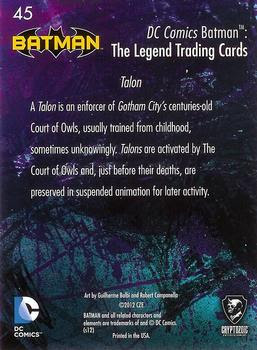 |
| Back of card for #45 - Talon |
Overall, this is a very good base set. The original art goes a long way, and in 63 cards they managed to capture a large portion of the most important Batman characters. A few other Bat Allies I would've liked to have seen (in card form): the Creeper, Nemesis, Bat-Cow, Sasha Bordeaux and a few more Batman Inc. members. The Bat villains, who I've always felt were more interesting than Batman himself, were also very well-covered. A few more I would've liked to have seen were Calendar Man, Hugo Strange, Hush, Killer Moth, KGBeast, Mr Zsasz, the Batman of Zur-En-Arrh and David Cain. There are so many interesting Bat villains that Cryptozoic could've made a trading card set based on them alone. As mentioned, 63 cards isn't a lot to work with, so I realize Cryptozoic had to tighten their selection criteria.
I'd recommend this trading card set to a new Batman fan - someone who was just getting into the comics and needed a fairly modern Who's Who with visuals. For the most part, the art is clean and crisp and the text on the back gives a general overview of the character. A serious Batman collector may overlook this base set (unless they are a completionist like myself), because I feel that the real prizes in this collection are the Artist Sketch cards and the Oversized Art cards. We'll talk about those in a minute, but first let's look at the chases...
The Batmobile foil chase cards were an interesting choice for a chase card sub-set. The Batmobile is one of Batman's most famous gadgets (moreso than his utility belt, I'd say) and definitely gave James Bond's tricked-out car a run for it's money. And we all know that Batman had a lot of different Batmobiles throughout the ages. You could probably make a trading card series simply based on vehicles Batman has driven throughout his career in crime-fighting - Eaglemoss basically did this with it's Batman Automobilia series.
 |
| Batmobile chase card BM-6 |
The Batcave puzzle cards are also foil cards, but these 9 chase cards form to reveal a really nice bird's-eye view of the Batcave.
 |
| Batcave chase card TBC-02 |
The last chase sub-set in this trading card set are the Circus of Villains Posters chase cards. There are 8 of these, and I really can't figure out why Cryptozoic didn't decide to make it an even 9 cards and fill up an entire card sheet. All the 'classical' Batman villains are here: Joker, Mr. Freeze, Penguin, Killer Croc, Scarecrow, Posion Ivy, Two-Face, Man-Bat. (Well, looks like Catwoman wasn't included in this one.)
These are actually very nice chase cards and have a very nice look to them. The fact that they're aren't a 9 card set doesn't bother me so much since they don't join to form a puzzle or anything. It's just a set of really nice chase cards.
The parallel holofoil base card variants are a good idea, in theory. They are the holofoil variants of the base cards. At an allocation of 1 in every 3 sealed packs, you're bound to pull a few of these if you purchase a sealed box of these cards. The thing is, not everything looks better with a reflective coating, and I should know since I grew up in the 'gimmick era' of comics. I'm personally way happier with the 'regular' non-holofoil base set. Of course, there are exceptions to every rule - I'm keeping a keen eye open for the holofoil variants of my favorite characters from this set [e.g., #36 - The Outsiders, #39 - Bane], because..well... wow.
Of all the nice things I've outlined in this trading card set, the BIG DEAL are the Artist Sketch Cards. Miranda Charsky, Cryptozoic's Brand Manager, issued a press release when this set was released, stating that "We had the privilege of working with over 140 sketch cards artists for the new set, and in addition to being approved by the creative team at DC, I reviewed every single card with our Art Acquisition Manager George Nadeau to give them a final stamp of approval". You're going to want to buy packs and packs of these cards to pick up the Sketch Artist cards. If you happen to complete the base card set and a few chase sub-sets along the way.. well, what's the harm in that? On that note, if you're looking for the 63-card base set, you'll be able to find on relatively cheap, since I imagine collectors bought boxes and boxes of these cards hoping to pull the Artist Sketch and/or Oversized Art Redemption cards and probably have a few non-holofoil base sets sitting around collecting dust.
I took a quick glance at the Sketch Artist list and only one name popped out at me (Tom Nguyen), the rest of these are complete 'unknowns' to me. (That's not saying that they're good or bad, it's just telling you how "out of the loop" I am on rising sketch artist stars.) The one thing that IS obvious is that these Sketch Artists are Batman fans, and have chosen a large diversity of characters to sketch.
Sketch Artist cards are a big 'hit or miss' for me, personally. To quote Orson Welles: “I don’t know anything about art but I know what I like”, and while a lot of the sketch cards are really nice, some are a little too 'cartoony' or anime for my tastes. If I pulled one of those, I'd be trying to quickly trade it for another sketch I'd prefer to own. Of course, this is just my own personal opinion, and I obviously don't feel the way the majority of collectors feel, since sketch cards for this set go for an average of $50 USD for a card - some as high as $175 USD. That being said, the ones that look great do really really look great and the artist's cover a wide range of characters that the base set seemed to have overlooked:
Like... wow!
Other than a folded up $100 bill, the Oversized Art Redemption card tops my list for "Things I Hope I Am Lucky Enough to Find In a Pack of Trading Cards Someday". The Oversized Art Redemption card is a regular-sized card you can find in a pack of cards that you mail in for 1 of 49 pieces of Oversized Original Art. As of this writing, according to the Cryptozoic site, 12 of the 49 have yet to be claimed. I've had a chance to glance at some of these pieces (which sell for about $130 USD on e-bay) and these look impressive. These are pretty difficult to find on the secondary market. If I ever manage to snag one, it's going in a frame on the wall of my office for all to admire.
 |
| Here's that Solomon Grundy the base set was missing... |
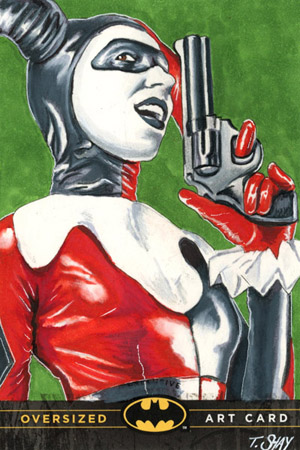 |
| Classical pre-New 52 Harley Quinn - just the way I was first introduced to her |
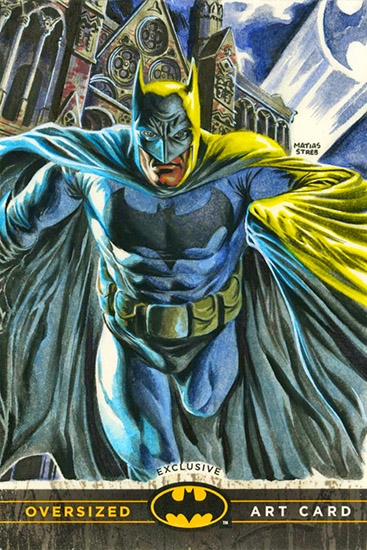 |
| What a beauty |
Cryptozoic was generous enough to let collectors see ALL of the Artist Sketch cards that are available on their Facebook page. It's worth taking a look at.
-Justin
Distribution as follows:
The Batmobile foil chase cards (1:12)
The Batcave chase cards (1:12)
Circus of Villains poster chase cards (1:24)
Artist Sketch cards (1:24)
Parallel holofoil base card (1:3)
Oversized Art Redemption cards (no clue, but there's only 49 of them)
Printing Plate card (1:576)
[Editor's note: Sometimes people around the web comment on these articles, but they only comment on the platform that linked to the article (e.g., Facebook, Google+). I will re-post the really insightful remarks in the comments section under 'Anonymous']






